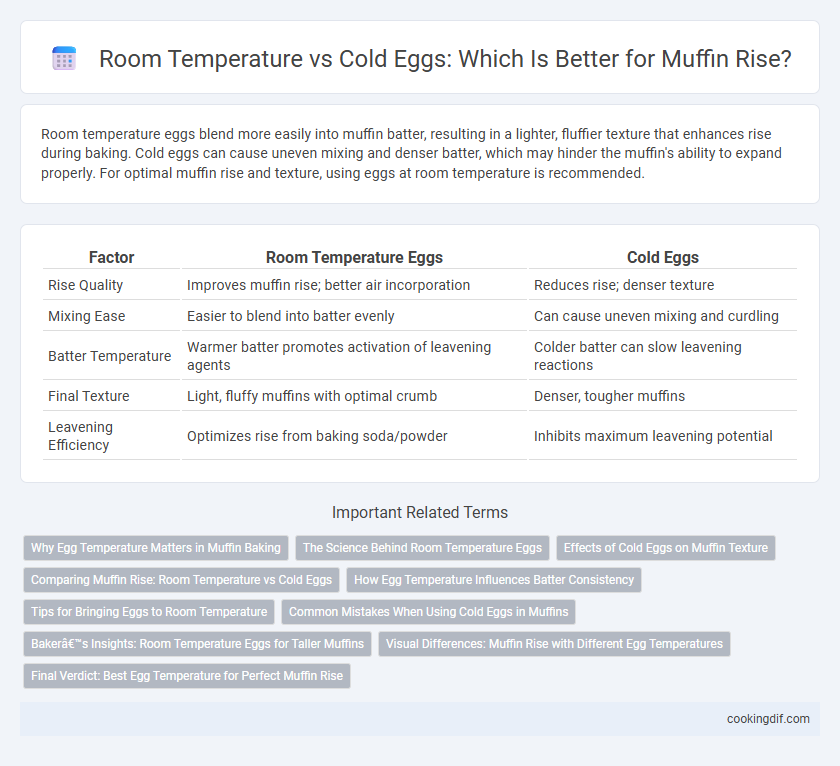Room temperature eggs blend more easily into muffin batter, resulting in a lighter, fluffier texture that enhances rise during baking. Cold eggs can cause uneven mixing and denser batter, which may hinder the muffin's ability to expand properly. For optimal muffin rise and texture, using eggs at room temperature is recommended.
Table of Comparison
| Factor | Room Temperature Eggs | Cold Eggs |
|---|---|---|
| Rise Quality | Improves muffin rise; better air incorporation | Reduces rise; denser texture |
| Mixing Ease | Easier to blend into batter evenly | Can cause uneven mixing and curdling |
| Batter Temperature | Warmer batter promotes activation of leavening agents | Colder batter can slow leavening reactions |
| Final Texture | Light, fluffy muffins with optimal crumb | Denser, tougher muffins |
| Leavening Efficiency | Optimizes rise from baking soda/powder | Inhibits maximum leavening potential |
Why Egg Temperature Matters in Muffin Baking
Egg temperature significantly affects muffin rise because room temperature eggs blend more easily with other ingredients, ensuring a uniform batter. Cold eggs can cause the fat in the batter to solidify, hindering proper aeration and resulting in denser muffins with less lift. Optimal muffin texture relies on maintaining even temperature, enhancing the reaction of baking powder or baking soda for maximum rise.
The Science Behind Room Temperature Eggs
Room temperature eggs blend more evenly with other muffin ingredients, enhancing the batter's emulsification and resulting in better rise. Cold eggs can cause the batter to seize or become uneven, hindering the expansion of trapped air bubbles during baking. The science behind room temperature eggs reveals that they promote optimal protein structure and leavening gas retention, contributing to lighter, fluffier muffins.
Effects of Cold Eggs on Muffin Texture
Cold eggs can slow down the creaming process of butter and sugar, resulting in less air incorporation and denser muffin batter. This reduced aeration negatively impacts the muffin rise, yielding a tougher and more compact crumb texture. Room temperature eggs facilitate better emulsification, promoting lighter, fluffier muffins with improved volume.
Comparing Muffin Rise: Room Temperature vs Cold Eggs
Muffin rise is significantly influenced by egg temperature, with room temperature eggs producing a better rise due to improved emulsification and aeration in the batter. Cold eggs can cause the batter to be denser and slower to expand, resulting in a lower muffin rise and a heavier texture. Using room temperature eggs helps create a lighter, airier muffin with optimal volume and a tender crumb.
How Egg Temperature Influences Batter Consistency
Room temperature eggs blend more easily into muffin batter, creating a smoother and more uniform consistency that enhances rising by trapping air effectively. Cold eggs tend to cause the batter to be denser and less cohesive, resulting in reduced volume and a heavier muffin texture. Proper egg temperature directly impacts the integration of ingredients and the muffin's final rise and aeration.
Tips for Bringing Eggs to Room Temperature
Bringing eggs to room temperature before baking muffins improves rise and texture by allowing better incorporation and aeration. To quickly warm cold eggs, place them in a bowl of warm water for 5 to 10 minutes or leave them on the counter for about 30 minutes. Avoid using a microwave to prevent uneven heating and potential curdling, ensuring optimal muffin batter consistency.
Common Mistakes When Using Cold Eggs in Muffins
Using cold eggs in muffins can cause common mistakes such as uneven rising and dense texture due to the batter not reaching optimal mixing temperature, which hinders proper incorporation of air. Cold eggs may lead to underdeveloped gluten, resulting in flat or heavy muffins instead of a light, fluffy rise. For best muffin rise, eggs should be at room temperature to ensure consistent batter texture and maximal leavening.
Baker’s Insights: Room Temperature Eggs for Taller Muffins
Baker's insights reveal that using room temperature eggs significantly improves muffin rise by incorporating better air retention into the batter, leading to taller, fluffier muffins. Cold eggs tend to slow the leavening process and create denser textures due to uneven mixing and temperature shock. Maintaining eggs at room temperature enhances the batter's consistency and allows optimal reaction with baking agents such as baking powder or baking soda.
Visual Differences: Muffin Rise with Different Egg Temperatures
Muffins made with room temperature eggs exhibit a higher and more uniform rise due to better integration of air into the batter, resulting in a lighter and fluffier texture. Cold eggs cause less expansion during baking, producing denser muffins with uneven tops and smaller air pockets. The visual difference is evident as muffins with room temperature eggs have a more rounded, domed appearance compared to the flatter, less structured rise of those with cold eggs.
Final Verdict: Best Egg Temperature for Perfect Muffin Rise
Using room temperature eggs in muffin batter enhances the rise by allowing better incorporation of air and smoother blending with other ingredients, leading to a lighter texture. Cold eggs can cause uneven mixing and lower batter temperature, which slows baking powder's reaction and results in denser muffins. For the perfect muffin rise, room temperature eggs are the optimal choice, ensuring maximum lift and fluffiness.
Room temperature eggs vs Cold eggs for muffin rise Infographic

 cookingdif.com
cookingdif.com